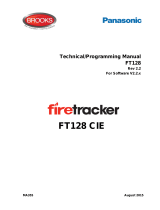Page is loading ...

SNA-360 addressable smoke detector
Installation Instructions
www.numens.net 1 32-0031-r02_2015-05
Cautions
ELECTRICAL HAZARD: Disconnect power from equipment prior to making
any internal adjustments. Service should only be performed by qualified
personnel.
FRAGILE: Inspect the equipment prior to installation. Do not install the
equipment if damage is apparent. Do not attempt to disassemble this
equipment. If damaged, return to the supplier.
ELECTROSTATIC HAZARD: This is sensitive electronic equipment. Apply
safe ant-static practices when handling this equipment.
CIRCUIT LIMITATIONS: The maximum number of detectors connected to
a single detection zone is limited by the control and indicating equipment,
and may be limited by local regulations.
Introduction
SNA-360 analogue addressable photoelectric smoke detectors
are microprocessor controlled state-of-the-art detectors suitable
for connection to Numens 2-wire addressable fire detection
control and indicating equipment.
These instructions provide trained installation personnel with
details to install and commission SNA-360 smoke detectors for
optimum performance.
Preparation
Before commencing installation, ensure all equipment and tools to
mount and connect the equipment are available, such as drills,
mounting screws, cables and ladders.
SNA-360 smoke detectors can be installed with the following
bases and accessories.
Description Part number Datasheet
4-terminal 102 mm low profile base CN302A 31-0036
8-terminal 102 mm low profile base CN304A 31-0038
Remote indicator
a
681-001 31-0027
a
Requires 8-terminal base.
Installation
Base
The base can be mounted directly onto an electrical junction box
such as an octagonal (75 mm, 90 mm or 100 mm), a round
(75 mm), or a square (100 mm) box without using any type of
mechanical adapter.
1. Feed the conductors through the middle of the base for
termination to the base contacts.
2. Mount the base on the junction box or directly onto a flat
surface.
3. Mount the base to the surface using fixing screws that are
suitable to securely fix the base to the surface.
Wiring
Base terminals accept (0.4 ~ 2.5) mm
2
conductors.
1. Strip the conductor insulation to expose 5 mm of the
conductor.
2. Connect the conductors to the base terminals as shown in
Fig. 1.
WARNING: Take care to ensure the insulation does not get
clamped by the terminal contact.
Fig. 1: Base wiring connections
Note 1: 8-terminal base required if a remote indicator is installed.
Note 2: If a remote indicator is not installed, the polarity of the zone circuit
wiring may be reversed.
WARNING: Do not short-circuit terminals 2 and 5.
3. Check the wiring for continuity, short circuits and earth faults.
Detector
WARNING: Do not install the detector head until the area is
thoroughly cleaned of construction debris, dust, etc.
1. Select the detector address and set the address as shown in
Table 1 by adjusting the DIP switch settings located on the
underside of the detector body.
Note: Addresses 0, 126 and 127 cannot be used.
2. Align the detector alignment mark with the short alignment
mark in the base, as shown in Fig. 2.
3. Mate the detector head onto the base and rotate it clockwise
to secure it. The long alignment marks should be aligned.
Fig. 2: Fitting the detector to the base
Commissioning
Smoke Detector
1. Ensure all the alarm signal services, releasing devices and
extinguisher systems are disabled during the commissioning
period.
2. Connect power to the detector for approximately 1 min.
Check that the detector is recognized and in the quiescent
condition at the control and indicating equipment. If the
detector is not shown or shows in fault, check the wiring for
the correct voltage and earth leakage. Replace the detector if
necessary.
3. Allow smoke from a cotton wick or a test smoke aerosol to
enter the detector-sensing chamber for at least 10 s. When
sufficient smoke has entered the chamber, the detector will
signal an alarm, by continuous illumination of the LED.
4. Upon alarm, immediately remove the smoke source.
5. Reset the detector from the control and indicating equipment.
6. Check that the detector LEDs are off and the control and
indicating returns to the quiescent condition.
Remote Indicator (where fitted)
Check that the indicator illuminates at the same time as the
detector LED.
Final Conditions
Ensure all the alarm signal services, releasing devices and
extinguisher systems disabled for the commissioning are returned
to their previous condition.
5
6
1
2
3
4
2
3
4
5
1
6
Alarm
Loop
Wiring
(to Control
Panel)
Alarm
Loop
Wiring
REMOTE
INDICATOR
L1 IN
- R
L2 L2
- R
L1 IN
Base
Detector head
Long Alignment Mark Short Alignment Mark

2 32-0031-r02_2015-05
Numens
46-2 MoGao Road, Dong Qian Lake, Ningbo, Zhejiang, China 315121
© 2015 Ambest Electronics (Ningbo) Co Ltd. All rights reserved. All specifications and other information shown were current at the date of publication
and subject to change without notice.
References
Document Description
31-0043 SNA-360 analogue addressable smoke detector
datasheet
View the complete range of products at
www.numens.net
Table 1 – DIP switch address settings
Most significant nibble
0000 1000 0100 1100 0010 1010 0110 1110
Least significant nibble
0000 —
a
16 32 48 64 80 96 112
1000 1 17 33 49 65 81 97 113
0100 2 18 34 50 66 82 98 114
1100 3 19 35 51 67 83 99 115
0010 4 20 36 52 68 84 100 116
1010 5 21 37 53 69 85 101 117
0110 6 22 38 54 70 86 102 118
1110 7 23 39 55 71 87 103 119
0001 8 24 40 56 72 88 104 120
1001 9 25 41 57 73 89 105 121
0101 10 26 42 58 74 90 106 122
1101 11 27 43 59 75 91 107 123
0011 12 28 44 60 76 92 108 124
1011 13 29 45 61 77 93 109 125
0111 14 30 46 62 78 94 110 —
a
1111 15 31 47 63 79 95 111 —
a
a
Address not permitted.
OFF
ON
38765421
/

